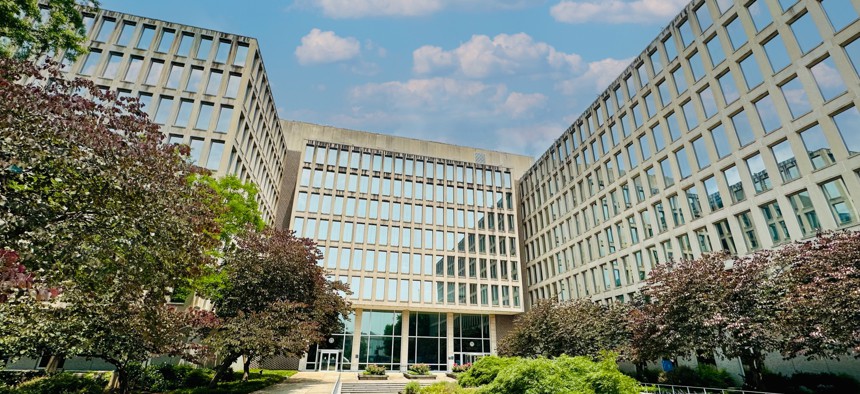
The Office of Personnel Management. Douglas Rissing / Getty Images
Trump’s new civil service hiring plan: Merit or Meritless?
COMMENTARY | OPM's new Merit Hiring Plan isn't based on a new principle, but its enactment could make Schedule F look quaint, says the former vice chairman of the Merit Systems Protection Board.
On May 29, 2025, the White House and Office of Personnel Management jointly released a 30-page Merit Hiring Plan that mandates new requirements and procedures for executive branch hiring. As a former Chief Human Capital Officer, OPM attorney and Merit Systems Protection Board vice chairman, I believe this new plan is filled with so many questionable legal and policy flaws that these new requirements make the Project 2025 proposed Schedule F regulation look quaint in comparison.
Why roll this out now? In the first several months of this administration, we witnessed a broad range of illegal and inhumane firings of thousands of civil servants, along with the removals of independent agency heads, board members, commissioners and inspectors general. This was more than just to rid the incoming administration from these “meddlesome” public servants. It was a path to create new vacancies and to install presidential loyalists. We are moving from “you’re fired” to “you’re hired.”
Is this strategy new? No. As our nation started to expand, in the late 19th century, we recognized that our government’s corruption and abuses were stunting our growth and threatening our security. That’s why we moved away from the spoils to a merit-based civil service with the passage of the Pendleton Act in 1883. Teddy Roosevelt, prior to becoming president, served on the Civil Service Commission and championed merit hiring and due process for civil servants. He noted that “opportunities should be made equal for all citizens; only those who had merit should be appointed to Federal jobs; and public servants should not suffer for their political beliefs.” This history is well chronicled in OPM's Biography of an Ideal, released in 2003 by the agency’s then director, Kay Coles James, and former president of The Heritage Foundation. Similarly, in the early 1970s, President Nixon sought to fire civil servants and replace them with his loyalists per the Malek manual. That attempt was stopped in its tracks when Congress, by an overwhelming bipartisan response (over 95%), voted for the Civil Service Reform Act of 1978. The act created the Merit System Principles and the Prohibited Personnel Practices, and separated out oversight powers by creating independent agencies such as the MSPB, OPM, Federal Labor Relations Authority and later, the Office of Special Counsel.
What does this new hiring plan do? After reading this 30-page hiring plan several times, I feel like the White House and OPM are taking us on some kind of psychedelic-quixotic adventure to make us believe that if we just clicked our heels and let the newly placed experts from X or Tesla make all the hiring decisions, our lives would be a lot easier.
Let’s break it down. Much of the plan simply focuses on past hiring reforms that were already underway. I know this because I served on OPM’s CHCO Council for 16 years, and we collectively worked on creating shared certificates so agencies could make selections from one job posting or create talent teams within agencies to share best practices. We already put in place getting managers involved earlier in the hiring process by making them subject matter experts to speed up hiring and improve effectiveness. In 2019, while CHCO at Interior, we were already doing SME hiring with help from the U.S. Digital Service before the Department of Government Efficiency (DOGE) blew it up. We also put in place improved background screenings and leveraged existing assessments through USA Hire.
CHCOs were always coming up with new and innovative hiring solutions. For example, at the 2019 CHCO Conference, I presented a white paper to collapse all the now existing 120 appointing authorities, currently covered under the competitive and excepted hiring authorities, into one authority called “The Merit Service.” Under this proposal, OPM, with additional investments, could leverage its USAJOBS’ technology and data with more than 17 million applications, and assess all applicants for minimum qualifications and background checks. This would free up resources from the 130 departments and agencies so they could focus their limited resources on assessments and final interviews. With more than 350,000 annual vacancies, this would have saved tens of millions of dollars in recruitment and selection costs while keeping all the merit and due process protections in place. However, the OPM/OMB political will and budget investments needed to make this happen were never advanced. Overall, most of OPM’s new plan is nothing new.
So, what’s the bad news? The real damage comes in several waves: 1. Agencies must abandon collecting demographic recruitment and workforce data, thereby crippling their ability to conduct strategic workforce planning and make data-informed decisions, all in a naïve attempt to make it harder for applicants to bring discrimination complaints; 2. Agencies must add new assessment/essay questions that will evidence the applicants’ support for the president’s executive orders and priorities; and 3. Agencies must identify a designee (likely a senior-level political appointee) to oversee the selection process instead of the career supervisor who is typically tasked with making the hiring decision.
I believe these new requirements will drag our nation back to the spoils era and raise legal and implementation challenges for agencies to confront. For example, will the new political hiring officials (likely not familiar with federal hiring statutes and regulations) be able to respond to investigators from the Department of Labor’s Veterans’ Employment and Training Service when veterans claim they were illegally passed over for a position, denied an opportunity to compete or were discriminated against based on their uniform service? Will those politicals be able to expertly testify before an EEOC or MSPB administrative judge that they followed all the federal statutory and regulatory hiring requirements? Will those new politically motivated assessment/essay questions withstand legal scrutiny as a valid employment practice? Will HR specialists or agency attorneys who try to prevent those abuses from occurring and suffer an adverse personnel action be considered whistleblowers because they attempted to prevent a Prohibited Personnel Practice or attempted to follow the rules?
Where do we go from here? In the immortal words of Taylor Twellman: “What are we doing?” As I now reflect on my 30 years of federal service, I really loved and appreciated the good work that was being done at OPM over the years. Today, I don’t even recognize it anymore. In all the agencies I worked, it was truly an honor and privilege to share the debates, the struggles and even the frustrations with all of my colleagues, but this time is different. However, if past is prologue, I’m equally confident that we will overcome this dark period and come out stronger for it. If you are currently a federal employee, don’t lose hope. Lean into your oath of office. So far, the lower federal courts are holding strong with respect to mass firings and issuing temporary injunctions, and clearly those judges haven’t forgotten their oaths. You got this and stay informed. Here are some good resources to check on frequently if you need additional support: Rise Up - Legal Defense Network; Civil Service Strong; and Partnership for Public Service. Thank you for your service!
Raymond Limon served in various executive human capital and legal positions at the Office of Personnel Management, Corporation for National and Community Service, State Department, Interior Department and Merit Systems Protection Board.






